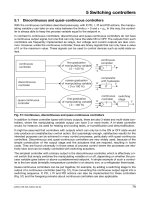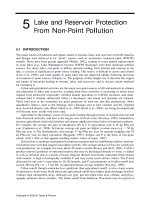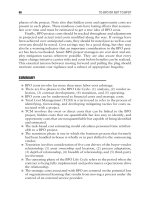Lecture management a pacific rim focus chapter 5 managerial decision making
Bạn đang xem bản rút gọn của tài liệu. Xem và tải ngay bản đầy đủ của tài liệu tại đây (470.3 KB, 27 trang )
CHAPTER 5
MANAGERIAL DECISION MAKING
© 2003 McGraw-Hill Australia Pty Ltd. PowerPoint
1
Lecture outline
• Nature of managerial
decision making
• Managers as decision
makers
• Effective decision
making
• Barriers to effective
decision making
• Group decision making
• Creativity in decision
making
© 2003 McGraw-Hill Australia Pty Ltd. PowerPoint
2
Decision making
Decision making
‘The process by which managers identify
organisational problems and try to
resolve them.’
© 2003 McGraw-Hill Australia Pty Ltd. PowerPoint
3
Nature of managerial decision
making
Types of problems faced:
• Crisis problems
Serious. Requires immediate action.
• Non-crisis problems
Requires resolution but not both immediate and
important.
• Opportunity problems
Opportunity for organisational gain IF appropriate
action taken.
© 2003 McGraw-Hill Australia Pty Ltd. PowerPoint
4
Nature of managerial decision
making
Decision making situations:
• Programmed decisions
Routine, repetitive, well-structured situations by use
of pre-determined decision rules.
• Non-programmed decision making
Pre-determined decision rules are impractical due to
novel &/or ill-structured situations.
• The element of risk
Possibility that a chosen decision could lead to
losses rather than intended results.
© 2003 McGraw-Hill Australia Pty Ltd. PowerPoint
5
Managers as decision makers
Models of managerial decision making:
• Rational model
Model suggesting managers engage in completely rational
decision processes, ultimately making optimal decisions, and
possess and understand all information relevant to their
decisions at the time they make them.
• Non-rational models
Models suggesting information gathering and processing
limitations make it difficult for managers to make optimal
decisions.
© 2003 McGraw-Hill Australia Pty Ltd. PowerPoint
6
Non-rational models
• Satisficing model
Managers seek alternatives only until they find one
which looks satisfactory, rather than seeking an
optimal decision.
• Incremental model
Managers make the smallest response possible to
reduce the problem to at least a tolerable level.
• Rubbish bin model
Managers behave in virtually a random way in
making non-programmed decisions.
© 2003 McGraw-Hill Australia Pty Ltd. PowerPoint
7
An
Anoptimal
optimaldecision
decision
isispossible
possible
All
Allrelevant
relevantinformation
information
isisavailable
available
All
Allrelevant
relevantinformation
informationisis
understandable
understandable
All
Allalternatives
alternativesare
areknown
known
Rational
Rational
decision
decision
making
making
All
Allpossible
possibleoutcomes
outcomesknown
known
© 2003 McGraw-Hill Australia Pty Ltd. PowerPoint
8
Time
Timeconstraints
constraints
Limited
Limitedability
abilityto
to
understand
understandall
allfactors
factors
Inadequate
Inadequatebase
base
of
ofinformation
information
Limited
Limitedmemory
memoryof
of
decision-makers
decision-makers
‘Satisficing’
‘Satisficing’
decision
decision
making
making
Poor
Poorperception
perceptionof
offactors
factors
to
tobe
beconsidered
considered
in
indecision
decisionprocess
process
© 2003 McGraw-Hill Australia Pty Ltd. PowerPoint
9
Effective decision making
Steps to effective decision making:
• Identify the problem
Scan for change, categorise as problem/non-problem,
diagnose nature and cause.
• Generate alternative solutions
Uncritically brainstorm to develop alternatives, combine &
improve ideas.
• Evaluate & choose an alternative
Feasibility, quality, cost, reversibility, ethics, acceptability.
• Implement and monitor
Plan and implement, evaluate effect on others, monitor.
© 2003 McGraw-Hill Australia Pty Ltd. PowerPoint
10
Identification
Identification
of
ofthe
theproblem
problem
Steps
Steps in
in decision-making
decision-making
Generate
Generatealternative
alternativesolutions
solutions
Evaluate
Evaluatealternatives
alternatives
Evaluation
Evaluation
of
of decision
decision
effectiveness
effectiveness
Choose
Choose
an
analternative
alternative
Implementation
Implementationand
andmonitoring
monitoring
of
ofthe
thechosen
chosenalternative
alternative
© 2003 McGraw-Hill Australia Pty Ltd. PowerPoint
11
Barriers to effective decision
making
• Complacency
Individuals either do not see signs of danger/opportunity or,
avoid them.
• Defensive avoidance
Individuals either deny the importance of a danger
/opportunity or deny any responsibility for taking action.
• Panic
Individuals become so upset they frantically seek a way to
solve the problem.
• Deciding to decide
Decision makers accept the challenge and follow an effective
decision-making process.
© 2003 McGraw-Hill Australia Pty Ltd. PowerPoint
12
Barriers to effective decisionmaking
Complacency
Defensive
avoidance
Panic
© 2003 McGraw-Hill Australia Pty Ltd. PowerPoint
13
Decision making bias
• Framing
Tendency to make different decisions depending on
how a problem is presented.
• Prospect theory
Decision makers find the prospect of an actual loss
more painful than giving up the possibility of a gain.
• Representativeness
Tendency to be overly influenced by stereotypes in
making judgements about the likelihood of
occurrences.
© 2003 McGraw-Hill Australia Pty Ltd. PowerPoint
14
Decision making bias
• Availability
Tendency to judge the likelihood of an occurrence on the
basis of the extent to which other like instances can easily be
recalled.
• Anchoring & adjustment
Tendency to be influenced by an initial figure, even when the
information is largely irrelevant.
• Overconfidence
Tendency to be more certain of judgements regarding the
likelihood of a future event than one’s actual predictive
accuracy warrants.
© 2003 McGraw-Hill Australia Pty Ltd. PowerPoint
15
Decision escalation
‘Escalating commitment
and accelerating losses’
Non-rational escalation: increased
commitment of resources beyond rational limits
Sunk costs: not recoverable, and
should not influence decision-making
© 2003 McGraw-Hill Australia Pty Ltd. PowerPoint
16
Group decision making
Advantages:
• More information
available
• Wide range of
ideas/approaches
• Improved acceptance
of decision
• Develops group
members’ skills
Disadvantages:
• More time consuming
• Disagreement/time
problems
• Open to individual
dominance
• Groupthink may arise
© 2003 McGraw-Hill Australia Pty Ltd. PowerPoint
17
Group decision making
Advantages
Advantages
Disadvantages
Disadvantages
More
Moreinformation
informationavailable
available
Time
Timeconsuming
consuming
More
More
alternative
alternativesolutions
solutions
Delays
Delays&&illillfeeling
feelingpossible
possible
Increases
Increasessolution
solution
understanding
understanding&&acceptance
acceptance
Domination
Dominationby
byindividuals
individuals
Builds
Buildsmember
member
knowledge
knowledge&&skill
skillbase
base
Risk
Riskof
ofgroupthink
groupthink
© 2003 McGraw-Hill Australia Pty Ltd. PowerPoint
18
Enhancing group decision
making
•
•
•
•
•
Heterogenous membership
Communication/social skills
Devil’s advocates
Dialectical inquiry
Groupware
© 2003 McGraw-Hill Australia Pty Ltd. PowerPoint
19
Techniques
Techniques to
to improve
improve group
group decisions
decisions
Member
Member diversity
diversity
Expert
Expert members
members
Devil’s
Devil’s advocates
advocates
Dialectic
Dialectic inquiry
inquiry
Better
Better
group
group
decision
decision
making
making
Groupware
Groupware use
use
© 2003 McGraw-Hill Australia Pty Ltd. PowerPoint
20
Creativity in decision making
‘Creativity is the cognitive process of
developing an idea, concept, commodity or
discovery viewed as novel by its creator or
target audience.’
© 2003 McGraw-Hill Australia Pty Ltd. PowerPoint
21
Creativity in decision making
Creativity requires both:
• Divergent thinking
Attempting to move logically to a problem solution.
• Divergent thinking
Generating new ways of viewing a problem and
seeking novel alternatives.
© 2003 McGraw-Hill Australia Pty Ltd. PowerPoint
22
Creativity in decision making
Three basic ingredients necessary for creativity:
• Domain-relevant skills
Expertise in a field relevant to the problem.
• Creativity-relevant skills
Skills in generating novel ideas, approaches, modes
of thinking about problems.
• Task motivation
Interest in the task for its own sake, a desire to
resolve the problem.
© 2003 McGraw-Hill Australia Pty Ltd. PowerPoint
23
Enhancing group creativity
•
•
•
•
Brainstorming
Nominal group technique
Delphi technique
Scenario analysis
© 2003 McGraw-Hill Australia Pty Ltd. PowerPoint
24
TECHNIQUES
TECHNIQUESTO
TOENHANCE
ENHANCEGROUP
GROUPCREATIVITY
CREATIVITY
Brainstorming
Brainstorming
Nominal
Nominal group
group
technique
technique
Delphi
Delphi
technique
technique
Better
Better
group
group
creativity
creativity
Scenario
Scenario analysis
analysis
© 2003 McGraw-Hill Australia Pty Ltd. PowerPoint
25









